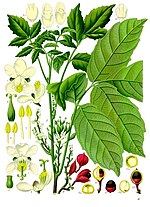Saponins (Latin "sapon", soap + "-in", one of) are bitter-tasting usually toxic plant-derived secondary metabolites, being organic chemicals, that have...
22 KB (2,253 words) - 07:26, 14 October 2024
Quillaia (section Saponin adjuvants)
Quillaia contains high concentrations of saponins that can be increased further by processing. Highly purified saponins from quillaia are used as adjuvants...
4 KB (385 words) - 04:09, 20 October 2024
Quillaja saponaria (section Uses of the saponins)
with water, owing to the presence of a glycoside saponin, sometimes distinguished as quillaia saponin. The same, or a closely similar substance, is found...
8 KB (853 words) - 04:19, 16 September 2024
of saponin, which has natural cleansing properties, and therefore the soapnut can be used as a cleanser for hair, skin, and clothing. These saponins are...
7 KB (821 words) - 15:52, 30 July 2024
cholesterol. This might be at least partly explained by the high saponin content of navy beans. Saponins also exhibit antibacterial and anti-fungal activity, and...
8 KB (931 words) - 00:25, 4 October 2024
Quinoa (section Saponins and oxalic acid)
the saponins in quinoa treats them as mild eye and respiratory irritants and as a low gastrointestinal irritant. In South America, these saponins have...
57 KB (6,095 words) - 13:46, 2 November 2024
< 30,000 Guanine Hypoxanthine Mucilage Protein < 98,600 Resin < 70,000 Saponin Starch 50,000–60,000 Tannin 50,000–120,000 Theobromine 200–400 Theophylline...
15 KB (1,352 words) - 07:21, 24 September 2024
paniculata. G. elegans is also used as a cut flower. The genus is a source of saponins that can be used for many purposes, including the production of photographic...
10 KB (864 words) - 00:15, 1 January 2024
Momordin is one of several saponins derived from oleanolic acid, a triterpenoid. These chemical compounds are found in some plants of the genus Momordica...
6 KB (603 words) - 04:45, 7 May 2024








